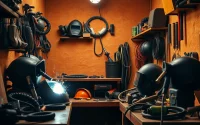Innovative Metal Drawer System: Design, Functionality, and Durability
Understanding the Metal Drawer System
Metal drawer systems are integral components in various furniture designs, ranging from kitchen cabinets to office drawers. They offer enhanced organization and accessibility while ensuring durability and a stylish aesthetic. In essence, these systems are engineered to facilitate smooth sliding of drawers, enhancing the user experience significantly. By exploring the Metal Drawer System, one can grasp the intricate design and functionality that contribute to this modern storage solution.
Definition and Components of Metal Drawer Systems
A metal drawer system typically consists of several components, including the drawer box itself, slides, and hardware such as brackets and hinges. The drawer boxes are often made from materials like steel or aluminum, which not only provide strength but also contribute to the overall aesthetic appeal.
The main components of a metal drawer system include:
- Drawer Box: Constructed from high-quality metal, offering strength and customization.
- Slides: These can be side-mounted, bottom-mounted, or concealed slides, facilitating the opening and closing of drawers.
- Hardware Accessories: Brackets and hinges that support the drawer and enhance stability during operation.
Each component is designed to work harmoniously, ensuring that the drawer operates smoothly while providing a balance of strength and aesthetic appeal.
Common Applications and Uses
Metal drawer systems are widely used in various applications due to their reliability and versatility. Common applications include:
- Kitchens: Drawers for utensils, cutlery, and pots benefit from the durable nature of metal systems.
- Office Furniture: Metal drawer systems are ideal for filing cabinets and desk drawers where reliability is paramount.
- Retail Displays: In retail environments, these systems enhance the visual appeal while providing practical storage for merchandise.
- Industrial Settings: Heavy-duty versions are used in workshops and garages, where strength and durability are crucial.
Benefits of Using Metal Drawer Systems
The advantages of incorporating metal drawer systems into your design or renovation project are numerous:
- Durability: Metal systems are resistant to wear and tear, making them suitable for heavy use environments.
- Low Maintenance: They require minimal maintenance, requiring only occasional cleaning, making them cost-effective over time.
- Versatility: Available in various styles and finishes, they can complement any decor.
- Functionality: Features like soft-close mechanisms and smooth gliding enhance user experience.
Key Features of Metal Drawer Systems
Design and Aesthetic Considerations
Metal drawer systems are not just about functionality; they also offer design versatility. They can be powder-coated or finished in various ways to match the theme of any space. Popular design considerations include:
- Color Options: From classic silver to custom colors, the finish can adapt to the interior style.
- Textures: Some metal drawers come with textured finishes, adding depth and uniqueness.
- Form Factor: Options are available in various widths and heights to fit specific spaces perfectly.
Load Capacity and Durability Factors
When choosing a metal drawer system, understanding load capacity is crucial. Most metal drawer systems can handle significant weight, with heavy-duty variants capable of supporting loads exceeding 100 lbs. Considerations include:
- Material Thickness: Thicker materials tend to support heavier loads.
- Slide Design: Ball-bearing slides typically facilitate smoother operation and better load distribution.
- Overall Construction: Reinforced corners and quality hinges enhance stability under load.
Variety of Styles and Finishes
The marketplace for metal drawer systems offers a plethora of choices that cater to diverse tastes and functional needs:
- Traditional: These often feature a more classic look with ornate detailing.
- Modern: Sleek lines and minimalistic designs embody contemporary aesthetics.
- Industrial: Raw metal finishes and rugged construction appeal to an urban style.
Moreover, finishes like chrome, satin, or matte enhance durability while providing visual appeal.
Installation Guide for Metal Drawer Systems
Tools Required for Installation
Installing metal drawer systems requires specific tools for a seamless procedure. Here’s a list of essential tools:
- Measuring tape
- Screwdriver
- Drill
- Level
- Adjustable wrench
- Clamps (optional)
Step-by-Step Installation Process
Installing a metal drawer system can be broken down into straightforward steps:
- Measure the Space: Obtain precise measurements of your cabinet or designated area.
- Choose the Right Drawer Box: Select a drawer box that fits the measurements and meets your needs.
- Attach the Slides: Fix the slides to the sides of the drawer box and the interior of the cabinet, ensuring level placement.
- Mount the Drawer Box: Slide the drawer box into the installed slides and check for smooth functionality.
- Final Adjustments: Make any necessary adjustments to ensure the drawer aligns correctly.
Common Installation Mistakes to Avoid
To ensure successful installation, it’s important to keep the following pitfalls in mind:
- Neglecting to measure accurately can lead to a poor fit.
- Forgetting to level the installation may result in drawers that do not open or close properly.
- Improperly securing the slides could lead to instability during use.
Maintenance and Care for Metal Drawer Systems
Cleaning Techniques and Best Practices
Maintaining metal drawer systems is essential to prolong their lifespan and keep them looking good. Here are some effective cleaning techniques:
- Regular Dusting: Using a microfiber cloth to regularly dust off surfaces can prevent the buildup of dirt.
- Gentle Cleaning Solutions: Use mild detergents and warm water for deeper cleaning, avoiding harsh chemicals that could damage the finish.
- Lubrication: Apply a silicone spray to the slides occasionally to enhance smooth operation.
Preventive Maintenance for Longevity
To ensure the longevity of your metal drawer system, consider the following preventive measures:
- Avoid overloading drawers to prevent strain on slides.
- Inspect the slides periodically for wear and tighten screws if necessary.
- Ensure that drawers are regularly opened and closed to maintain functionality.
Troubleshooting Common Issues
Even with preventive measures, issues may arise. Common problems include:
- Drawer Sticking: Check for obstructions or ensure slides are properly lubricated.
- Squeaking Sounds: This can be resolved with silicone or grease applied to sliding parts.
- Misalignment: Adjust the mounting screws to rectify misalignment issues.
Choosing the Right Metal Drawer System
Budget Considerations and Cost Analysis
When selecting a metal drawer system, budget plays a critical role. Costs can vary based on material quality, brand, and complexity:
- Entry-Level Options: Basic systems are more affordable and are suitable for lightweight applications.
- Mid-Range Systems: These offer an optimal balance between quality and functionality.
- High-End Metal Systems: Premium systems may include advanced features, such as soft-close mechanisms and heavy-duty materials.
Comparing Brands and Products
It is vital to compare various brands and products when selecting a metal drawer system. Look for:
- Reputation: Established brands often have proven track records for quality and support.
- Warranty: A robust warranty can provide peace of mind regarding durability.
- Customer Reviews: User feedback can offer insights into performance and potential issues.
Getting the Best Value for Your Investment
Finally, ensuring you get the best value requires careful consideration:
- Balancing quality and cost is essential; opt for the best quality within your budget.
- Evaluate features against your specific needs, ensuring that unnecessary features do not inflate costs.
- Consider long-term savings from durability and maintenance costs associated with the system.


